The Shrine (1/1)
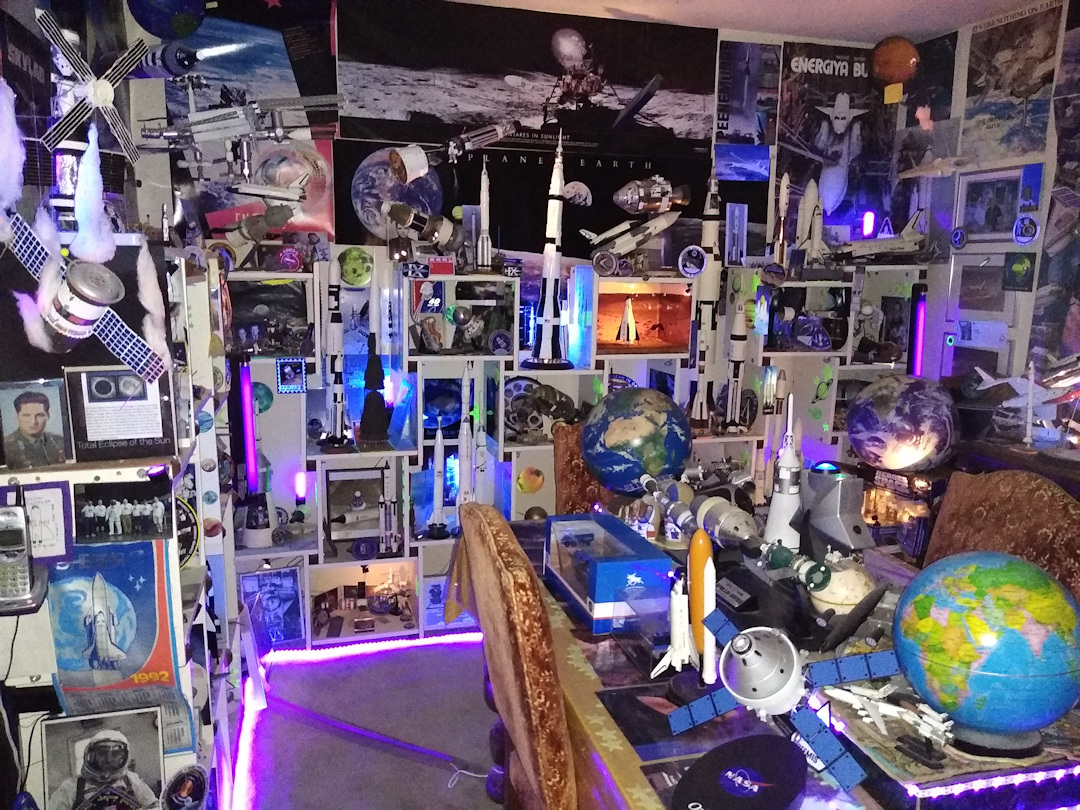
This is a photo of my diningroom/space museum. My friend the late Barry Shanko once referred to it as a "shrine to aerospace technology" and the name "The Shrine" has stuck ever since. There are models, displays, photos and posters on all four walls, and an increasing number of models hung from the ceiling in recent years. Hanging models from the ceiling is partly due to lack of shelf space, but perhaps more importantly because some subjects are very large (e.g., space stations) and do not lend themselves well to being placed on a shelf. In addition to the models I have built, there are contractor models, souvenirs, fairly accurate space toys and other collectables and memorabilia relating to space flight spread throughout the room.
Over the years my approach to displaying models has evolved and changed. Rather than just "models sitting on a shelf" I am now attempting to "create an environment". This "environment" is perhaps best experienced after nightfall when the lighting in the room is entirely under my control instead of mother nature's. There are now three projectors focussed on the ceiling, 14 sources of ultravoilet light, and a number of mini-spotlights to highlight certain subjects placed around the room. I am trying to get just the right balance of "black" and "white" light, so you get a sense of the darkness of space, but yet have enough light to see the models and displays fairly well. Much of the lighting comes from secondary sources from various "glow-in-the-dark" items (e.g., stars, planets, silly putty) placed around the room, and especially near the models on display. This is supplemented by lighting from very small spotlights for some models, and various "educational toys" like a Moon that goes through phases, as well as illuminated Earth and Mars in the 3 corners of the room away from the entrance. There is a globe that spins and is lit with the light from the cities on Earth at night. Unfortunately the result does not photograph too well, at least with the equipment and skills I possess, but the best of the photos I have are shown here.
As well, in recent years I have tried to better develop "themes" in the individual "cubby holes" on the display shelves. Some of my favourites are shown here, such as the Sputnik display, the Vostok display, the Voskhod 2 display and the Gemini-Agena display.
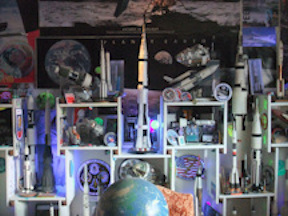 The Shrine - main wall (click to enlarge)
The Shrine - main wall (click to enlarge) The Shrine - 1/72 scale corner (click to enlarge)
The Shrine - 1/72 scale corner (click to enlarge)
 The Shrine - lighting at night (click to enlarge)
The Shrine - lighting at night (click to enlarge)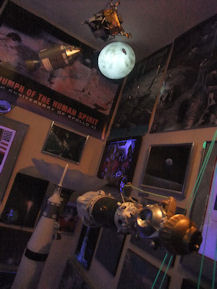 The Shrine - Moon corner (click to enlarge)
The Shrine - Moon corner (click to enlarge) Sputnik display (click to enlarge)
Sputnik display (click to enlarge)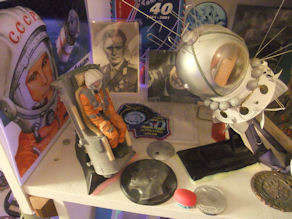 Vostok display (click to enlarge)
Vostok display (click to enlarge)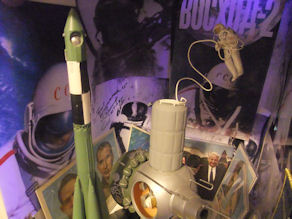 Voskhod 2 display (click to enlarge)
Voskhod 2 display (click to enlarge)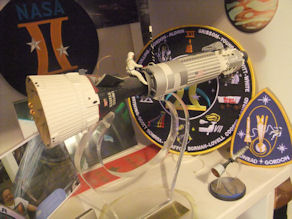 Gemini-Agena display (click to enlarge)
Gemini-Agena display (click to enlarge)V-2 (A-4) (1/69)

The V-2, which was known by its designers as the A-4, represents perhaps the single most important development in the history of rocketry. It heralded the transition of the rocket from realm of small, experimental devices to large, operational weapons systems, and in doing so also opened the door to spaceflight.
The V-2 was developed during the Second World War in Germany by a team led by Dr. Wernher von Braun at Peenemunde (click to go to page 2 with info on my trip to Peenemunde) on the Baltic coast. This rocket integrated a number of great technical innovations for its day. For example, for the first time fuel components (in this case liquid oxygen) were circulated inside the walls of the rocket engine to cool the engine bell, which otherwise would have melted.
The V-2 entered WWII very late, in late 1944 and 1945, and hit targets in London and Belgium. It was more effective as a weapon of terror than for the destructive impact of its one-ton bomb, and had no significant influence on the outcome of the war. However, after the war both the Americans and the Soviets captured and tested V-2s, eventually beginning development of their own series of rocket weapons and booster systems by reverse engineering captured V-2s. In the late 40s and early 50s V-2s, with upper stages added, took the first probes into space on suborbital flights. And of course, the von Braun group went to America and developed rockets for the US including the Redstone, Jupiter, and Saturn series, culminating in the Saturn V which took the first men to the Moon.
This V-2 model is from the Revell 1/69 scale kit. It is depicted in a diorama during the war on its trailer/transporter. To highlight the details of the V-2's propulsion system the fuel/oxydizer tanks and engine are displayed in front of the diorama with a mirror placed underneath to afford better viewing. There is also a huge 1/16 scale model of the first V-2 to enter space hanging from the ceiling in my kitchen (see photo on page 2).
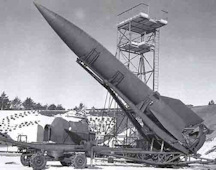 V-2 on transport trailer in World War II (click to enlarge)
V-2 on transport trailer in World War II (click to enlarge)
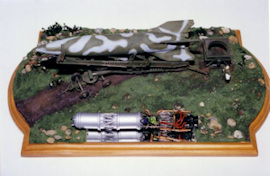 V-2 model diorama (click to enlarge)
V-2 model diorama (click to enlarge)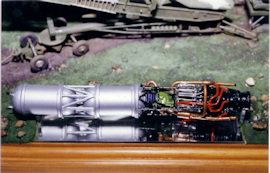 V-2 model diorama showing engine details (click to enlarge)
V-2 model diorama showing engine details (click to enlarge)Sputnik 2 (1/30)
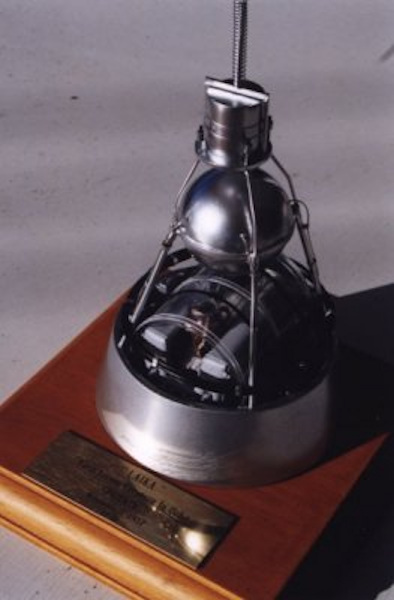
On October 4th, 1957 the Soviet Union launched "Sputnik", the first artificial Earth satellite (AES). The world, especially the United States, was stunned, having historically considered the USSR to be a backwards nation, not up to the level of sophistication of American technical know-how.
Less than a month after Sputnik, on November 3rd, 1957, the Soviet Union launched the second AES, Sputnik 2. The West was shocked to learn that this second satellite carried the first living creature into orbit, the dog Laika. Sputnik 2 certainly signalled,if there had been any doubt previously, that the USSR would be working towards sending a man in into space eventually. Unfortunately at this early stage in the development of space technology there was no way to return the spacecraft to Earth, and Laika died within a few days.
There is now considerable evidence that, while the US could have fairly easily achieved this feat first, it was US President Dwight Eisenhower's intention to let the USSR put a satellite in orbit ahead of them. Before the mid-50s the military capabilities of Soviet Union, with its vast impenetrable land mass, was a huge unknown to the US. Eisenhower was under pressure from the US Congress to increase military spending to address the "bomber gap" and later the "missile gap", and had limited data with which he could counter these pressures. Already in development, even before Sputnik's launch, was the first American spy satellite program, Corona. But why would the Soviet Union, which forebade aircraft to overfly its territory, allow a satellite to overfly? (even if they were unaware it was for reconnaissance purposes) Hence, the theory that perhaps it was Eisenhower's preference that the USSR orbit the first satellite, to establish the precedent that space overflight was different than air overflight, and acceptable to the other superpower.
Interestingly, when more data from overflights of the USSR later did become available to the US, starting in 1956 from the U-2 spy plane (until Francis Gary Powers was shot down in a U-2 over the Soviet Union in May 1960), and then beginning in August 1960 with photos from Corona (which orbited under the guise of the US Airforce's "Discoverer" scientific satellite series), it became evident that the US had a considerable lead on the USSR in strategic nuclear missiles. Indeed, from the perspective of Soviet Premier Nikita Krushchev, this may have been the biggest value of the early Soviet victories in the "Space Race" - that it gave the American public, and to a lesser extent their government, the impression that the Soviet Union had considerably greater strategic missile capabilties than it really had, thereby hopefully reducing the possibility of a "first strike" against the Soviet Union by the US.
This model of Sputnik 2, my little memorial to Laika, is entirely scratchbuilt. Thanks to Toys-R-Us for the plastic dog figure.
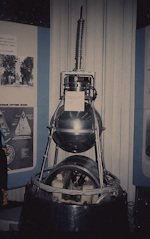 Back-up Sputnik 2, NPO Energia Museum, Russia (click to enlarge)
Back-up Sputnik 2, NPO Energia Museum, Russia (click to enlarge) Sputnik 2 model with
Laika visible (click to enlarge)
Sputnik 2 model with
Laika visible (click to enlarge)Soyuz T (1/100) & Soyuz TM-15 (1/72) Rockets
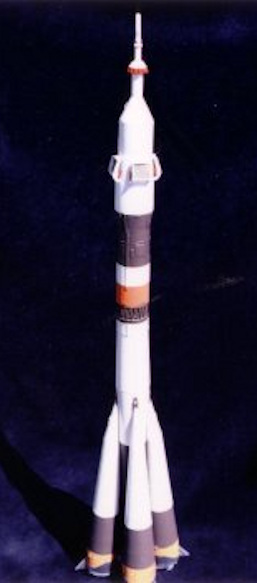
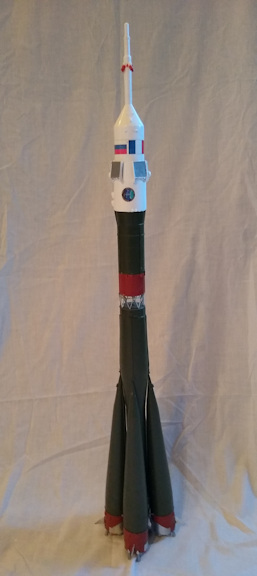
The Soyuz rocket in its many variations has been the most well utilized booster for manned space flight in history. The origins of this rocket go back to the early 1950's and the Soviet Union's development of the world's first Intercontinental Ballistic Missile (ICBM) the R-7, or "Semiyoka". The first successful test flight of this first ICBM took place in August 1957. On October 4th of that year the same rocket was used to launch the world's first artificial Earth satellite,"Sputnik" (click for photo of model). The Soyuz booster in use today still utilizes essentially the same rocket for its first stage.
The R-7 consisted of a central core stage with a four chamber engine surrounded by four conical shaped stap-on boosters (click for photo of model), each with a similar four chamber engine, all of which were fueled by kerosene and liquid oxygen. These strap-ons drop off after the first few minutes of flight, leaving the core stage to continue firing. In the case of the early sputniks there was no upper stage and, in fact, the entirety of the core stage was placed into orbit along with the satellite payload. The large lift capacity of this rocket, the need for which ironically was driven by the relatively primative state of Soviet thermonuclear weapon technology at the time which resulted in much heavier bombs than comparable explosive yield American weapons, placed the Soviets ahead of the Americans in the "Space Race" for many years, in fact well into the mid-1960s.
To increase the lift capacity of the R-7 various upper stages have been added over the years. In 1959 an upper stage was added to boost Luna 1 to become the first man-made object to travel in the vicinity of the moon. A variation on this upper stage was used for the Vostok launcher (click for photo of model) which placed the first men in orbit in 1961. In the mid '60s a more powerful upper stage became available and was used as the Voskhod booster (click for photo of model), which was a heavier, modified Vostok used to take the first multi-man crews into orbit. Since 1967 variations on this upper stage have been used to boost the many versions of the Soyuz manned spacecraft into orbit. The Soyuz T variant, modelled here, was in use in the early 1980s for several years before being replaced by the improved Soyuz TM spacecraft and booster.
Today, besides regularly launching crews in Soyuz spacecraft or Progress supply ferries to the International Space Station (ISS), the Soyuz booster remains a frequently called upon workhorse for the launch of many other unmanned satellites for weather, communications, reconnaisance, etc. Russian technology, at least by comparison to American technology, tends to be simpler but more robust and, if it works, they just keep using it. The long history of Soyuz booster is a classic demonstation of this philosophy that underlies Russian engineering.
The Soyuz T model is based on the MPC 1/100 Vostok launcher kit for the first stage, with an entirely scratchbuilt upper stage, spacecraft shroud and launch escape tower. The Soyuz TM-15 rocket is from the MACH 2 1/72 kit. This is the rocket I saw launched in Baikonour in July 1992, and further details on that exciting trip can be found on the home page of this website.
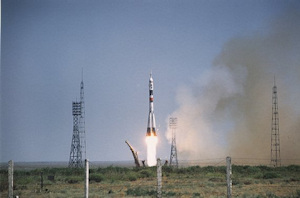 Soyuz TM 15 launch July 27, 1992 - photo by the author (click to enlarge)
Soyuz TM 15 launch July 27, 1992 - photo by the author (click to enlarge)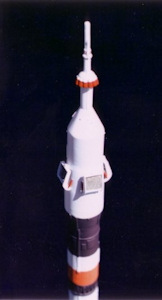 Soyuz T launcher (1/100) - detail (click to enlarge)
Soyuz T launcher (1/100) - detail (click to enlarge)Mercury-Atlas (1/48)
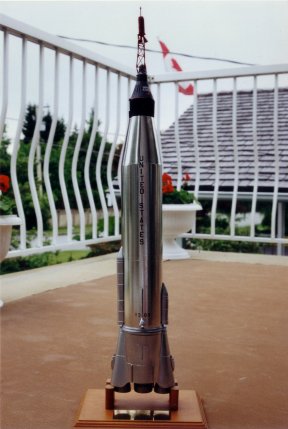
The Atlas was America's first intercontinental ballistic missile (ICBM). It was developed in the 1950's just slightly later than the Soviet R-7 rocket (click to go to Soyuz-T launcher section for more info on the R-7). In fact the R-7 and the Atlas share many characteristics besides both being their respective nations' first ICBMs. Both were fueled by kerosene and liquid oxygen. Both consisted of 1 1/2 stage designs, where the the core "sustainer" stage as well as booster/strap-on engines were ignited on the ground, with the booster stage/strap-ons dropping off after several minutes leaving only the core/sustainer engine to continue firing. (click for photo of model demonstrating Atlas staging) And both the Atlas and the R-7 were modified to boost their respective nations' first men into orbit (though the first two Americans in space made suborbital missions using the smaller Mercury-Redstone (click for photo of model)).
However, the Atlas was considerably smaller than the R-7 with a smaller lift capacity to orbit, which ironically was as a result of the American's more sophistocated thermonuclear weapon techology at the time the two rockets were designed, allowing for the American thermonuclear weapons to be smaller and lighter than Soviet weapons of comparable destructive yield. Variations on both the Atlas (click for video on launch of today's Atlas V) and the R-7 (click to go to section on Soyuz launcher) are still in use today.
This 1/48 model depicts the last Mercury-Atlas launch vehicle, MA-9 or "Faith 7", in which Gordon Cooper made 22 orbits of the Earth over a day and a half in space in May 1963. The Atlas is based on the Eagle's Talon multi-media kit (resin, lucite tube, etc.) and the Mercury is from Revell's 1/48 Mercury-Gemini kit.
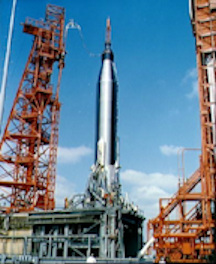 Mercury-Atlas 9 (Faith 7) being prepared for launch, May 1963 (click to enlarge)
Mercury-Atlas 9 (Faith 7) being prepared for launch, May 1963 (click to enlarge)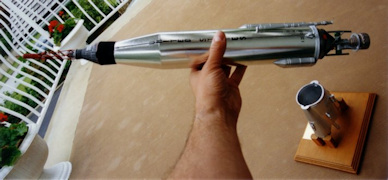 staging of Mercury-Atlas model (click to enlarge)
staging of Mercury-Atlas model (click to enlarge)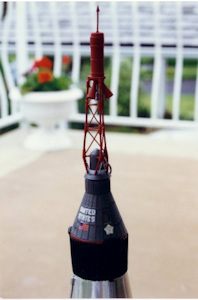 detail of Mercury-Atlas 9 (Faith 7) model (click to enlarge)
detail of Mercury-Atlas 9 (Faith 7) model (click to enlarge)
Vostok (1/30)
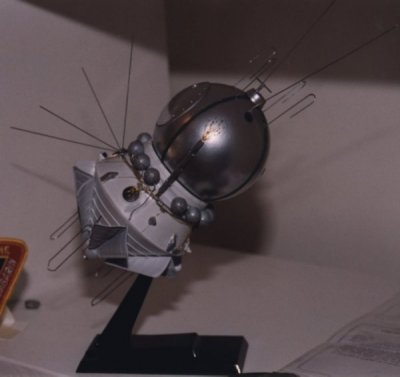
This model is of the first manned spacecraft, the Soviet Vostok. This was a one-person spacecraft first flown by Yuri Gagarin, the first man in space, who made one orbit of the Earth on April 12th, 1961. This vehicle made six manned flights between 1961 and 1963, the last flight of the series placing the first woman in space, Valentina Tereshkova, in June 1963.
The Vostok in many ways was a simplier craft than its contemporary, the American Mercury manned spacecraft. Most of the Vostok flight was pre-programmed, and the cosmonaut actually did no real "flying" of the spacecraft, unless required to do so because of system failure(s). This is in contrast to the Mercury, which was designed (under some pressure from the Original 7 US astronauts) to require a pilot's input during flight.
This model is based on the Ogonjek kit made in the Soviet Union and available (if you had connections) for a period in the West in the mid-1980s. It has been extensively detailed, most notably with the addition of the extended radiator panels on the retro module.
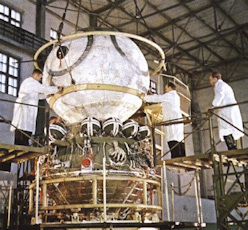 Vostok spacecraft being assembled in the 1960s (click to enlarge)
Vostok spacecraft being assembled in the 1960s (click to enlarge) Vostok model (click to enlarge)
Vostok model (click to enlarge)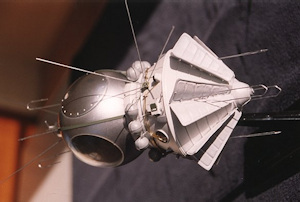 Vostok model (click to enlarge)
Vostok model (click to enlarge)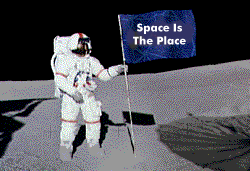
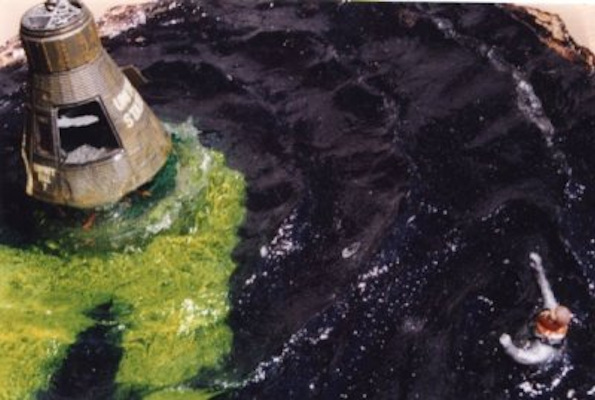
 The attempted recovery of Liberty Bell 7, July 21st, 1961 (click to enlarge)
The attempted recovery of Liberty Bell 7, July 21st, 1961 (click to enlarge) The Loss of Liberty Bell 7 - from above (click to enlarge)
The Loss of Liberty Bell 7 - from above (click to enlarge)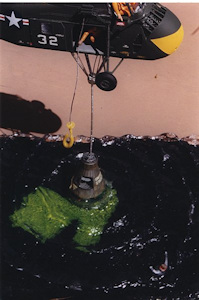 The Loss of Liberty Bell 7 - detail (click to enlarge)
The Loss of Liberty Bell 7 - detail (click to enlarge)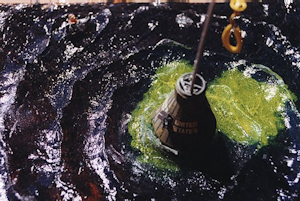 The Loss of Liberty Bell 7 - detail (click to enlarge)
The Loss of Liberty Bell 7 - detail (click to enlarge)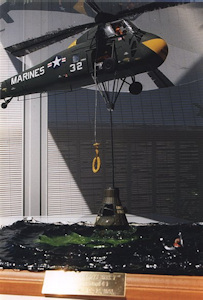 The Loss of Liberty Bell 7 - detail (click to enlarge)
The Loss of Liberty Bell 7 - detail (click to enlarge)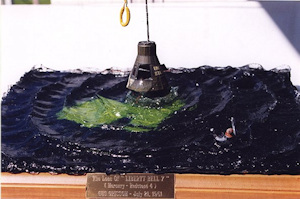 The Loss of Liberty Bell 7 - detail (click to enlarge)
The Loss of Liberty Bell 7 - detail (click to enlarge)